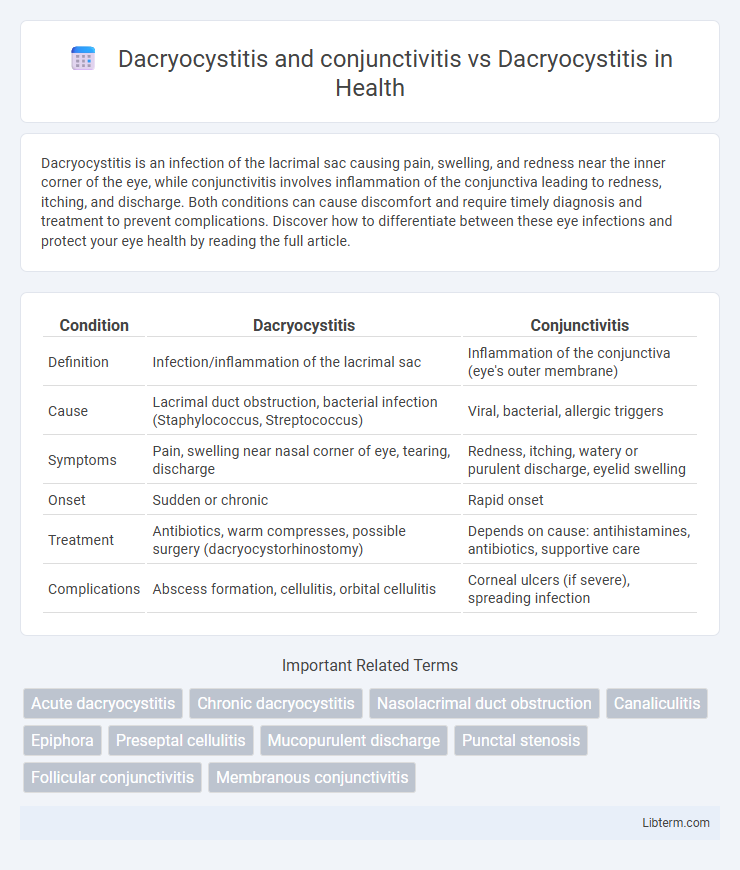Dacryocystitis is an infection of the lacrimal sac causing pain, swelling, and redness near the inner corner of the eye, while conjunctivitis involves inflammation of the conjunctiva leading to redness, itching, and discharge. Both conditions can cause discomfort and require timely diagnosis and treatment to prevent complications. Discover how to differentiate between these eye infections and protect your eye health by reading the full article.
Table of Comparison
| Condition | Dacryocystitis | Conjunctivitis |
|---|---|---|
| Definition | Infection/inflammation of the lacrimal sac | Inflammation of the conjunctiva (eye's outer membrane) |
| Cause | Lacrimal duct obstruction, bacterial infection (Staphylococcus, Streptococcus) | Viral, bacterial, allergic triggers |
| Symptoms | Pain, swelling near nasal corner of eye, tearing, discharge | Redness, itching, watery or purulent discharge, eyelid swelling |
| Onset | Sudden or chronic | Rapid onset |
| Treatment | Antibiotics, warm compresses, possible surgery (dacryocystorhinostomy) | Depends on cause: antihistamines, antibiotics, supportive care |
| Complications | Abscess formation, cellulitis, orbital cellulitis | Corneal ulcers (if severe), spreading infection |
Introduction to Dacryocystitis and Conjunctivitis
Dacryocystitis is an infection of the lacrimal sac often caused by obstruction of the nasolacrimal duct, leading to pain, swelling, and tearing near the inner corner of the eye. Conjunctivitis, commonly known as pink eye, is inflammation or infection of the conjunctiva, characterized by redness, itching, and discharge. Differentiating dacryocystitis from conjunctivitis is critical as dacryocystitis requires targeted antibiotic therapy to prevent complications, whereas conjunctivitis often resolves with supportive care or topical treatments.
Defining Dacryocystitis: Causes and Symptoms
Dacryocystitis is an infection of the lacrimal sac typically caused by obstruction of the nasolacrimal duct leading to bacterial overgrowth, most commonly from Staphylococcus aureus or Streptococcus species. Symptoms include pain, redness, swelling near the inner corner of the eye, excessive tearing, and sometimes discharge. Distinct from conjunctivitis, which primarily affects the conjunctiva and presents with diffuse eye redness and irritation, dacryocystitis localizes inflammation to the lacrimal sac area and often requires targeted treatment to address the underlying blockage and infection.
Understanding Conjunctivitis: Types and Triggers
Dacryocystitis is an infection of the lacrimal sac often caused by nasolacrimal duct obstruction, whereas conjunctivitis refers to inflammation of the conjunctiva with types including bacterial, viral, allergic, and chemical. Common triggers for conjunctivitis involve allergens, irritants, infectious agents like adenovirus, and environmental factors, distinguishing it from the primarily bacterial etiology of dacryocystitis. Proper differentiation between conjunctivitis types and dacryocystitis is crucial for targeted treatment and preventing complications like chronic dacryocystitis or conjunctival scarring.
Key Differences: Dacryocystitis vs. Conjunctivitis
Dacryocystitis is an infection of the lacrimal sac caused by obstruction of the nasolacrimal duct, resulting in pain, swelling, and redness near the inner corner of the eye, whereas conjunctivitis involves inflammation of the conjunctiva, presenting with redness, itching, and discharge from the eye. Dacryocystitis often causes localized tenderness and purulent discharge upon pressure over the lacrimal sac, while conjunctivitis typically affects the entire conjunctiva with diffuse redness and watery or mucous discharge. Treatment differs as dacryocystitis may require systemic antibiotics and possible surgical intervention, whereas conjunctivitis is commonly managed with topical medications depending on its bacterial, viral, or allergic cause.
Dacryocystitis with Conjunctivitis: Overlapping Features
Dacryocystitis with conjunctivitis presents overlapping clinical features such as tearing, redness, and swelling near the medial canthus, complicating accurate diagnosis. Both conditions involve inflammation but dacryocystitis specifically affects the lacrimal sac due to nasolacrimal duct obstruction, while conjunctivitis primarily involves the conjunctiva with discharge and irritation. Identifying concomitant conjunctival involvement in dacryocystitis is critical for targeted treatment and preventing complications like orbital cellulitis or persistent infection.
Diagnostic Approaches in Dacryocystitis and Conjunctivitis
Diagnostic approaches in dacryocystitis involve clinical examination of the lacrimal sac with signs of swelling, redness, and tenderness near the medial canthus, often confirmed by lacrimal sac irrigation to assess for obstruction. Conjunctivitis diagnosis centers on identifying conjunctival hyperemia, discharge type, and patient history, supported by bacterial cultures or viral PCR tests to determine etiology. Differentiating dacryocystitis from conjunctivitis relies on localization of inflammation and presence of purulent lacrimal sac expression versus diffuse conjunctival involvement.
Treatment Strategies for Dacryocystitis Alone
Treatment strategies for dacryocystitis primarily focus on antibiotic therapy to target the underlying bacterial infection, often involving systemic antibiotics such as amoxicillin-clavulanate or clindamycin. In cases of abscess formation, incision and drainage may be necessary to alleviate pain and prevent complications. Definitive management frequently requires surgical intervention, typically dacryocystorhinostomy, to restore proper tear drainage and prevent recurrence.
Management of Coexisting Dacryocystitis and Conjunctivitis
Management of coexisting dacryocystitis and conjunctivitis involves a combination of systemic and topical antibiotic therapy targeting the common causative bacteria such as Staphylococcus aureus and Streptococcus species. Lacrimal sac irrigation and warm compresses help reduce obstruction and discharge, while corticosteroid eye drops may be prescribed to control conjunctival inflammation without exacerbating infection. Early intervention with appropriate antibiotic regimens and addressing nasolacrimal duct obstruction are crucial to prevent complications and promote resolution of both infections.
Prognosis and Complications: Combined vs. Isolated Dacryocystitis
Dacryocystitis combined with conjunctivitis often results in a more prolonged inflammatory response and increased risk of corneal involvement compared to isolated dacryocystitis, leading to a more guarded prognosis. Complications such as preseptal cellulitis, orbital cellulitis, and lacrimal sac abscess occur more frequently when conjunctivitis coexists, requiring aggressive antibiotic therapy and sometimes surgical intervention. Isolated dacryocystitis typically resolves with appropriate medical management but may still progress to chronic obstruction or fistula formation if untreated.
Preventive Measures and Patient Education
Preventive measures for dacryocystitis and conjunctivitis emphasize maintaining proper eyelid hygiene, regular handwashing, and avoiding eye rubbing to reduce bacterial contamination and tear duct blockage. Patient education should highlight early recognition of symptoms such as tearing, redness, and swelling, and stress the importance of timely medical evaluation to prevent complications like chronic infection or abscess formation. Emphasizing compliance with prescribed treatments and follow-up appointments ensures effective management and reduces recurrence risk for both dacryocystitis and conjunctivitis.
Dacryocystitis and conjunctivitis Infographic

 libterm.com
libterm.com